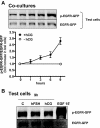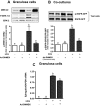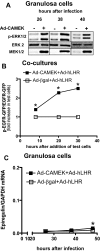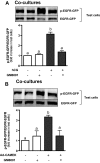The luteinizing hormone receptor-activated extracellularly regulated kinase-1/2 cascade stimulates epiregulin release from granulosa cells
- PMID: 18653716
- PMCID: PMC2584583
- DOI: 10.1210/en.2008-0618
The luteinizing hormone receptor-activated extracellularly regulated kinase-1/2 cascade stimulates epiregulin release from granulosa cells
Abstract
We examine the pathways involved in the luteinizing hormone receptor (LHR)-dependent activation of the epidermal growth factor (EGF) network using cocultures of LHR-positive granulosa cells and LHR-negative test cells expressing an EGF receptor (EGFR)-green fluorescent protein fusion protein. Activation of the LHR in granulosa cells results in the release of EGF-like growth factors that are detected by measuring the phosphorylation of the EGFR-green fluorescent protein expressed only in the LHR-negative test cells. Using neutralizing antibodies and real-time PCR, we identified epiregulin as the main EGF-like growth factor produced upon activation of the LHR expressed in immature rat granulosa cells, and we show that exclusive inhibition or activation of the ERK1/2 cascade in granulosa cells prevents or enhances epiregulin release, respectively, with little or no effect on epiregulin expression. These results show that the LHR-stimulated ERK1/2 pathway stimulates epiregulin release.
Figures







References
-
- Liang CG, Su YQ, Fan HY, Schatten H, Sun QY 2007 Mechanisms regulating oocyte meiotic resumption: roles of mitogen-activated protein kinase. Mol Endocrinol 21:2037–2055 - PubMed
-
- Seger R, Hanoch T, Rosenberg R, Dantes A, Merz WE, Strauss III JF, Amsterdam A 2001 The ERK signaling cascade inhibits gonadotropin-stimulated steroidogenesis. J Biol Chem 276:13957–13964 - PubMed
-
- Zeleznik AJ, Saxena D, Little-Ihrig L 2003 Protein kinase B is obligatory for follicle-stimulating hormone-induced granulosa cell differentiation. Endocrinology 144:3985–3994 - PubMed
-
- Su YQ, Nyegaard M, Overgaard MT, Qiao J, Giudice LC 2006 Participation of mitogen-activated protein kinase in luteinizing hormone-induced differential regulation of steroidogenesis and steroidogenic gene expression in mural and cumulus granulosa cells of mouse preovulatory follicles. Biol Reprod 75:859–867 - PubMed
Publication types
MeSH terms
Substances
Grants and funding
LinkOut - more resources
Full Text Sources
Research Materials
Miscellaneous

